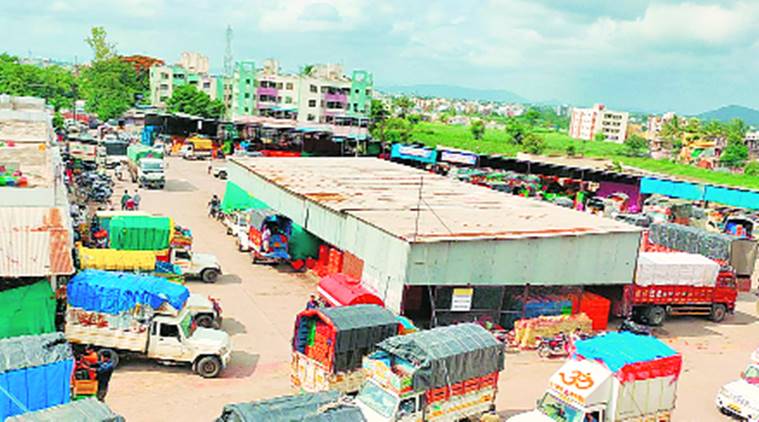- India
- International
Maharashtra’s big APMCs see no threat from trading reforms
Narayangaon wholesale market for tomatoes in Junnar taluka of Pune district has seen no drop in arrivals of the red berry or farmer and trader footfall.
 Trucks waiting to load tomatoes at the Narayangaon APMC. (Photo: Parthasarathi Biswas)
Trucks waiting to load tomatoes at the Narayangaon APMC. (Photo: Parthasarathi Biswas)
Four years since the Maharashtra government’s decisions to “delist” fruits and vegetables from being compulsorily bought and sold in APMC (agricultural produce market committee) mandis, it is business as usual at Narayangaon.
This bustling wholesale market for tomatoes in Junnar taluka of Pune district has seen no drop in arrivals of the red berry or farmer and trader footfall. And that may hold some clues to the likely impact of the Centre’s own recent reform dismantling the monopoly of APMCs in the trading of agri-produce and giving farmers the freedom to sell directly to wholesalers, retailers, processors and exporters or even through electronic platforms.
Deepak Bhise, a farmer from Yedgaon village, about 7 km from the Narayangaon APMC, plants tomatoes on his entire four-acres holding in February-March for harvesting in August-September. Back in June 2016, when the then Devendra Fadnavis-led NDA government in Maharashtra announced delisting of horticultural produce from the ambit of APMC trading, he was quite upbeat.
“I thought buyers will flock to my farm,” recalls the 31-year-old, whose tomato yields average 18-20 tonnes per hectare. Bhise, then, tried to strike deals with traders for lifting straight from his fields. A leading online grocer even approached him for supplying 10 tonnes. “After taking delivery of the produce that I supplied in 20-kg crates, they said that the tomatoes were not red enough. Not only did I not receive full payment, they even did not return my crates,” he says.
That bitter experience has led Bhise to go back to selling at the APMC. “Once in a while, I get enquiries through online platforms, but their requirement is often in kilos when my harvest in a single picking is in tonnes. What will I do with my remaining produce,” he points out, while describing the Centre’s recent Farmers’ Produce Trade and Commerce (Promotion & Facilitation) Ordinance as “good on paper”.

Yogesh Shinde, who is from the same village and grows pomegranate and papaya on his eight acres, nods in agreement. “I am not comfortable with traders who come and ask if they can lift straight from my field. I would rather deal with commission agents at Gultekdi (Pune) and Vashi (Mumbai) APMCs. Yes, I have to spend on transport, but at least there is surety and promptness in payment,” he says.
Bhise, like Shinde, has experimented with selling to online players and direct-to-consumer platforms. But there are two problems with them. “Their orders are too small for it to be feasible for us to deliver. Secondly, they want the best of the pick. So, what do we do with the balance quantity? Only the APMCs have the liquidity from a large number of buyers, due to which we can offload our entire produce. And there is a market for the best as well average and not-so-good grade,” adds Shinde, who annually harvests 8 tonnes per acre of papayas and 12-15 tonnes in the case of pomegranates.
Sanjay Dufare, a trader at Narayangaon whose firm supplies tomatoes to wholesale markets in Mumbai, Delhi and Kolkata, is even less impressed with the Narendra Modi government’s market reform ordinance issued on June 5. “For somebody like me, it makes more sense to buy from a place where farmers themselves bring their produce. Most farms are scattered and have no navigable roads for me to send pick-up trucks. What else is a mandi for? And where else can I get such a wide variety of produce to choose from?,” he states.
Proof of the limitations of reforms is market arrivals. The Narayangaon APMC – which also trades in other vegetables such as brinjal, bitter gourd, cauliflower, cabbage and onion – recorded total arrival of 29.47 lakh quintals in 2014-15 (October-September) and 33.26 lakh quintals in 2015-16. Despite vegetables being “delisted” from exclusive trading in APMCs, this mandi saw arrivals of 37.37 lakh quintals in the 2018-19 marketing year.
The move to permit fruits and vegetables to be traded outside the physical boundaries of APMC yards without attracting any mandi cess had led to a seven-day strike called by traders, especially in the Vashi market of Navi Mumbai. The Fadnavis administration had, nevertheless, pushed through what was then seen as a significant reform.
But four years down the line, figures from the Maharashtra State Agricultural Marketing Board (MSAMB) shows the total arrivals of fruits and vegetables in APMC mandis across the state to have more or less remained the same: from 949 lakh quintals in 2014-15 and 1,138 lakh quintals in 2015-16 to 1,235 lakh quintals, 1,183 lakh quintals and 1,122 lakh quintals in the subsequent three marketing years (October-September).
“Hardly any trade has gone out of the APMCs after the 2016 reform. Nothing much will change even with the latest reform that goes beyond fruits and vegetables. Some business may shift to organised retailers and various online platforms, but the major APMCs – Lasalgaon for onions, Narayangaon for tomatoes, Nashik for other vegetables, Sangola and Indapur for pomegranates or Latur for soyabean and pulses – will definitely survive. Farmers and traders will themselves ensure that,” admits an MSAMB official.
Apr 26: Latest News
- 01
- 02
- 03
- 04
- 05








































